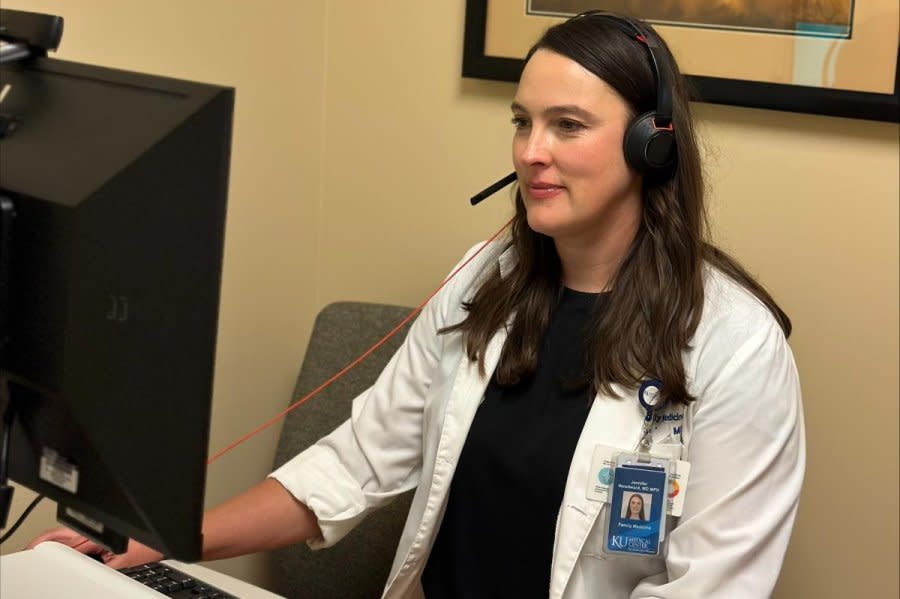Bolstered by the pandemic, telemedicine takes hold in U.S.

NEW YORK, Aug. 23 (UPI) -- After telemedicine use accelerated during the COVID-19 pandemic, remote patient monitoring devices to track a patient's health from home have become increasingly popular.
Remote patient monitoring allows clinicians to manage acute and chronic conditions, while reducing patients' travel costs and infection risk, according to the U.S. Health Resources & Services Administration.
Symptoms and conditions that can be tracked through remote patient monitoring include high blood pressure, diabetes, weight loss or gain, heart problems, chronic obstructive pulmonary disease, sleep apnea and asthma.
"Remote patient monitoring saw a rapid increase with COVID-19 as a new-use case, augmented by federal and state flexibilities put in place during the public health emergency to allow for the widespread use of telehealth services," Bill Paschall, co-chair of the American Telemedicine Association's remote monitoring special interest group, told UPI via email.
Patients use devices that may be familiar to them, such as weight scales, pulse oximeters, blood glucose meters and blood pressure monitors. Some ailments require more complicated devices that necessitate patient training, including monitors for sleep apnea, heart conditions, dementia and Parkinson's disease, and breathing apparatuses.
This month, Rush University System for Health in Chicago began remote patient monitoring for Medicare and Medicaid patients with hypertension, congestive heart failure and Type 2 diabetes. Patients are receiving devices for monitoring by a nurse practitioner-led care team, as well as at-home labs, medications and coaching.
Remote patient monitoring "is increasingly being recognized as something healthcare systems must do rather than just a nice thing to have," Dr. Michael Cui told UPI via email.
Cui is an assistant professor in the division of general internal medicine and associate chief medical informatics officer at Rush.
"COVID-19 helped jumpstart the adoption of remote patient monitoring by leaps and bounds," Cui said, adding that reimbursement to providers is available for remote patient monitoring, which makes it sustainable.
"The response has almost uniformly been positive. Patients like being able to share information with their doctor and have really appreciated us reaching out and discussing their readings with them," he said.
"Remote patient monitoring helps us as the healthcare system develops a deeper and stronger relationship with patients. We don't have to wait every few months to communicate with our patients; we can engage with them on a weekly or even daily basis, if needed."
The percentage of physicians who used remote monitoring devices grew to 30% in 22 from 12% in 2016, according to the American Medical Association.
"RPM is on the rise as the method to bridge the gap between the growing aging population and the severe shortage of health care professionals" Paschall of the American Telemedicine Association said.
"The appropriate use of technology and timely human intervention is the only way to provide continual care to the growing number of health consumers with chronic conditions."
The U.S. Centers for Medicare & Medicaid Services has introduced new billing codes to facilitate payment for remote monitoring services, and Paschall noted that this helped fuel rapid growth.
Remote patient monitoring is particularly effective at inducing behavioral changes that help improve patients' outcomes, Rob Havasy, senior director at Chicago-based HIMSS, (the Healthcare Information and Management Systems Society), told UPI via email.
"When a scale reminds them every morning that they still have some weight to lose, and they believe a doctor or nurse is also seeing that number, they make different decisions about what to eat and how much to exercise than when they are on their own," Havasy said.
"Eventually, the individual decisions turn into habits and the course of chronic diseases can be altered."
For example, he noted that in a patient with heart failure, shortness of breath results from reduced pulmonary function caused by a buildup of fluid around the heart.
Unable to measure fluid pressure directly, remote patient monitoring usually tracks an individual's weight precisely and considers rapid gains overnight or over a couple of days as a sign of fluid buildup.
Medical professionals then can prescribe diuretics or other drugs prevent the condition from becoming worse.
The University of Kansas Health System in Kansas City, Kan., performs remote patient monitoring for chronic obstructive pulmonary disease, heart failure, Type 2 diabetes and hypertension, the executive director of continuum of care, Jason Grundstrom, told UPI via email.
Grundstrom collaborates with several providers, including Dr. Jennifer Woodward, an associate professor and vice chair of clinical services, family medicine and community health.
The hospital sends patients a combination of devices such as a weight scale, blood pressure cuff, blood glucose monitor and pulse oximeter. Some also receive a touch screen tablet, which aids in connecting the devices.
"Patients have shared they are very happy knowing a nurse or healthcare team member is watching their data and checking in on them when out of range. They feel supported," Woodward told UPI via email.
If necessary, she can adjust their medications and "then they will hopefully come to their next appointment with vitals controlled."
Grundstrom said that even though remote patient monitoring has reduced hospital readmissions by controlling health issues before they escalate, charges are not reimbursed consistently throughout the country. In Kansas City, he said few health insurers pay for this service.
Co-pays have been a limiting factor, Woodward said, noting that many patients have declined remote monitoring enrollment due to out-of-pocket costs.
"One caveat that we must keep in mind is the unintended consequence of further contributing to health disparities," Kirsten Langdon, a psychologist and associate director of Brown-Lifespan Center for Digital Health at Brown University in Providence, R.I., told UPI via email.
"One must also consider how social or structural determinants of health and access-related issues prevent equal opportunities particularly for the uptake of new technologies."
Among the devices used by patients at the center are mobile apps that passively track sleep, movement and language patterns, as well as wearable watches that monitor sleep, heart rate, physical activity and other biomarkers.

